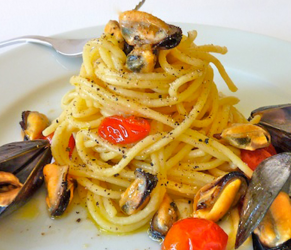To a New York child of the 1960s like myself, a tomato was an entity that came in plastic trays of three, had an unattractive pale pink color, and a texture that was both crunchy and squishy at the same time. Ironically, since the tomato is a New World food, it was a trip to the Old World that opened my palate to the bliss of tasting a great tomato. It was in a village of a small Greek-island, around 1972, where I first really savored a tomato. While much has happened since to diminish the quality of crops in Greece (agri-business, globalization, hybrids, greenhouses, bio-chaos and more), comparatively speaking there still is nothing quite like a Greek vine-ripened tomato.
Tomatoes are relative newcomers to the European kitchen cabinet. In the 16th century, when the Spanish first brought the fruit to Europe from America, most people were afraid to eat it. For about a century, it was cultivated as a decorative plant before anyone dared bite into it. While no one can be sure when that first did happen, it is known that by the mid-19th century, people were experimenting with it in the kitchen. The Italians, more than anyone else, were those who used it the most. It is probably thanks to them that the Greeks got to know it, via the Venetians who occupied the Ionian islands from the 15th to the 19th century. To this day, perhaps more than anywhere else in the country, the tomato is extremely prominent in the cuisine of those islands.
Indeed, the places in Greece that seem more tied to the tomato than others, are the places most closely associated with a strong Italian presence: On the island of Chios for example, which was governed by the Genoese, tomatoes play a major role in the local cuisine. One can see them strung and dried from rafters all summer long. In Tinos, which also endured a lengthy Venetian hold, sun-dried tomatoes appear in several unusual dishes. Likewise, Santorini claims its own indigenous, waterless tomato. For decades, until tourism supplanted farming as a major occupation, the island’s economy was based on the tomato canning industry.
Today, a major farming zone for tomatoes is the Peloponnesos. In fact, Peloponnese tomato canning is one of the country’s largest businesses, although the local crop is, ironically, the small plum tomato. All summer long, the sweet-sour smell of fermenting tomatoes seems to permeate the whole region. You can still see tomatoes sun-drying on planks in the small villages. Through late autumn, truckloads of sweet ripe tomatoes slow you down on the National Road.
A Brief Note on Tomatoes in the Greek Kitchen
Greeks prefer to flavor their tomato sauces with aromatic spices such as cinnamon and allspice, rather than dried herbs such as basil. Combined with the country’s delicious olive oil, these sauces tend to be rich and thick, almost a meal by themselves. We cook tomatoes with eggs too, in loose, omelet-like dishes. We stuff tomatoes, and of course prepare the Greek Village Salad, a dish that can be judged based on the ripeness and juiciness of the tomato.
The Exquisite Tomato
Greek tomatoes, a staple ingredient within the country's cuisine, are unlike tomatoes anywhere else in the world.
Country:
Related Articles
Most Popular recipes



































































